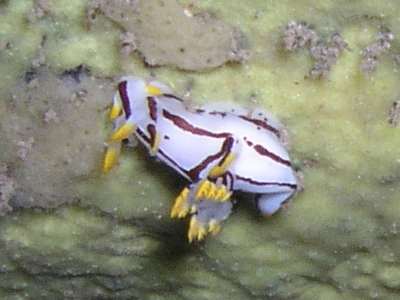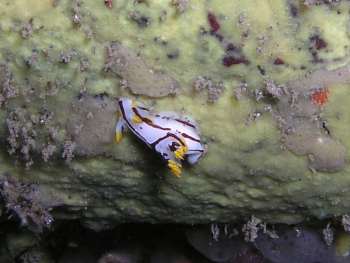
Trapania velox
(Cockerell, 1901)
Order: NUDIBRANCHIA
Suborder: DORIDINA
Superfamily: ANADORIDOIDEA
Family: Goniodorididae
DISTRIBUTION
Carmel, California, USA to Bahia Tortugas, Baja California, Mexico [Behrens & Hermisillo, 2005].
PHOTO
South Monastery Beach, Carmel, California, USA. Pacific Ocean. Depth: 43 feet. Length: 8-10 mm. 21 January 2006. At the south end of a reef parallel to the beach about 400 yards out from shore. Photographer: Hans Crommenacker
Small translucent white goniodorid with a pattern of dark blackish brown longitudinal lines down the body. There is one down the dorsal midline from the front of the head back to near the gills where it branches out each side. Behind the gills the line continues on to the posterior tip of the foot. On each side of the dorsum another line runs back from just behind the rhinophores to the posterior part of the foot. There can also be a black submarginal line just in from the edge of the foot. There is also a blackish brown line along the side of the extra rhinophoral and extra branchial processes. The oral tentacles, rhinophores and lateral processes are tipped with yellow, as are the gills and the posterior end of the foot. It is reported to grow to 20 mm in length.
-
Behrens, D. W. and Hermosillo, A. (2005) Eastern Pacific Nudibranchs. A Guide to the Opisthobranchs from Alaska to Central America. Monterey, California, Sea Challengers. 1-137.
-
Cockerell, T.D.A. (1901) Three new nudibranchs from California. Journal of the Malacological Society of London, 8: 85-87.
-
MacFarland, F. M. (1966) Studies of Opisthobranchiate Mollusks of the Pacific coast of North America. Memoirs of the California Academy of Sciences 6: 1-546.
Rudman, W.B., 2006 (January 24) Trapania velox (Cockerell, 1901). [In] Sea Slug Forum. Australian Museum, Sydney. Available from http://www.seaslugforum.net/find/trapvelo
Related messages
Trapania velox in Carmel, California, USA
January 25, 2006
From: Hans van den Crommenacker
I spotted this tiny nudibranch while diving south Monastery beach in Carmel, California. It looked very different than the usual ones we see in Monterey. I carry an Olympus C5050 camera without a strobe and I take snapshots to ID what we see.
Locality: South Monastery Beach, Carmel, California, USA. Pacific Ocean. Depth: 43 feet. Length: 8-10 mm. 21 January 2006. At the south end of a reef parallel to the beach about 400 yards out from shore. Photographer: Hans Crommenacker
The pictures led me to believe it was a Trapania velox....The northern range of Trapania velox listed in Behrens' Pacific Coast Nudibranchs is Hazard Canyon, San Luis Obispo County, which is about 100 miles south of Carmel. Searching the local dive reports there was an October 2004 sighting nearby.
My dive buddy, Joel, contacted Clinton Bauder who regularly contributes to the forum. He confirmed seeing it on the same type of sponge in 2004.
The excitement of seeing a new-to-me nudibranch and having a few reasonable pictures prompted me to email David Behrens and Hans Bertsch. Their kind responses confirmed that we saw a Trapania velox. I did not realize that just seeing a nudibranch could generate this much excitement and fun.
Happy diving,
Hans
hcrommen@gmail.com
van den Crommenacker, H., 2006 (Jan 25) Trapania velox in Carmel, California, USA. [Message in] Sea Slug Forum. Australian Museum, Sydney. Available from http://www.seaslugforum.net/find/15634
Dear Hans,
Dave Behrens has included Clinton Bauder's record from Carmel in his recent Eastern Pacific Nudibranchs (Behrens & Hermosillo, 2005) which I sgould be reviewing soon. It is nice to get a confirmatory report to show it wasn't just a once-off aberration. It is also nice to add another species to the Forum. Although species of Trapania are generally associated with sponges, they don't actually feed on sponges, but instead feed on small stalked animals called entoprocts which are often found growing on particular sponges.
Best wishes,
Bill Rudman
